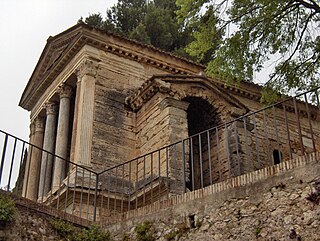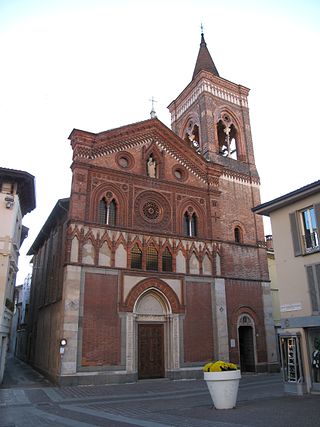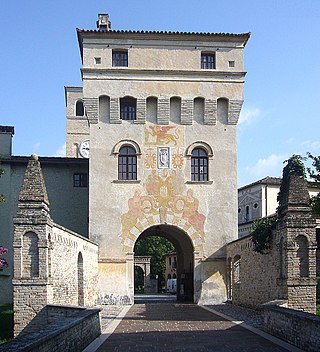
Cividale del Friuli is a town and comune in the Province of Udine, part of the North-Italian Friuli Venezia Giulia regione. The town lies 135 metres (443 ft) above sea-level in the foothills of the eastern Alps, 15 kilometres (9 mi) by rail from the city of Udine and close to the Slovenian border. It is situated on the river Natisone, which forms a picturesque ravine here. Formerly an important regional power, it is today a quiet, small town that attracts tourists thanks to its medieval center.

The Parish Basilica of Santa Maria del Popolo is a titular church and a minor basilica in Rome run by the Augustinian order. It stands on the north side of Piazza del Popolo, one of the most famous squares in the city. The church is hemmed in between the Pincian Hill and Porta del Popolo, one of the gates in the Aurelian Wall as well as the starting point of Via Flaminia, the most important route from the north. Its location made the basilica the first church for the majority of travellers entering the city. The church contains works by several famous artists, such as Raphael, Gian Lorenzo Bernini, Caravaggio, Alessandro Algardi, Pinturicchio, Andrea Bregno, Guillaume de Marcillat and Donato Bramante.

Romanesque art is the art of Europe from approximately 1000 AD to the rise of the Gothic style in the 12th century, or later depending on region. The preceding period is known as the Pre-Romanesque period. The term was invented by 19th-century art historians, especially for Romanesque architecture, which retained many basic features of Roman architectural style – most notably round-headed arches, but also barrel vaults, apses, and acanthus-leaf decoration – but had also developed many very different characteristics. In Southern France, Spain, and Italy there was an architectural continuity with the Late Antique, but the Romanesque style was the first style to spread across the whole of Catholic Europe, from Sicily to Scandinavia. Romanesque art was also greatly influenced by Byzantine art, especially in painting, and by the anti-classical energy of the decoration of the Insular art of the British Isles. From these elements was forged a highly innovative and coherent style.

San Pietro in Montorio is a church in Rome, Italy, which includes in its courtyard the Tempietto, a small commemorative martyrium (tomb) built by Donato Bramante.

The Certosa di Pavia is a monastery and complex in Lombardy, Northern Italy, situated near a small town of the same name in the Province of Pavia, 8 km (5.0 mi) north of Pavia. Built in 1396–1495, it was once located on the border of a large hunting park belonging to the Visconti family of Milan, of which today only scattered parts remain. It is one of the largest monasteries in Italy.

Santa Maria in Vallicella, also called Chiesa Nuova, is a church in Rome, Italy, which today faces onto the main thoroughfare of the Corso Vittorio Emanuele and the corner of Via della Chiesa Nuova. It is the principal church of the Oratorians, a religious congregation of secular priests, founded by St Philip Neri in 1561 at a time in the 16th century when the Counter Reformation saw the emergence of a number of new religious organisations such as the Society of Jesus (Jesuits), the Theatines and the Barnabites.

Santi Luca e Martina is a church in Rome, Italy, situated between the Roman Forum and the Forum of Caesar and close to the Arch of Septimus Severus.

The Duchy of Friuli was a Lombard duchy in present-day Friuli, the first to be established after the conquest of the Italian peninsula in 568. It was one of the largest domains in Langobardia Major and an important buffer between the Lombard kingdom and the Slavs, Avars, and the Byzantine Empire. The original chief city in the province was Roman Aquileia, but the Lombard capital of Friuli was Forum Julii, modern Cividale.

The Duomo of Monza, often known in English as Monza Cathedral, is the main religious building of Monza, Italy. Unlike most duomos, it is not in fact a cathedral, as Monza has always been part of the Diocese of Milan, but is in the charge of an archpriest who has the right to certain episcopal vestments including the mitre and the ring. The church is also known as the Basilica of San Giovanni Battista from its dedication to John the Baptist.

San Salvatore is a former monastery in Brescia, Lombardy, northern Italy, now turned into a museum. The monastic complex is famous for the diversity of its architecture which includes Roman remains and significant pre-Romanesque, Romanesque and Renaissance buildings.

Santa Maria del Carmine is a church in Pavia, Lombardy, northern Italy, considered amongst the best examples of Lombard Gothic architecture. It was begun in 1374 by Gian Galeazzo Visconti, Duke of Milan, on a project attributed to Bernardo da Venezia. The construction followed a slow pace, and was restarted in 1432, being finished in 1461.

The so-called Temple of Clitumnus is a small early medieval church that sits along the banks of the Clitunno river in the town of Pissignano near Campello sul Clitunno between Spoleto and Trevi, Umbria, Italy. In 2011, it became a UNESCO World Heritage Site as part of a group of seven such sites that mark the presence of Longobards in Italy: Places of Power.

The Palazzo Grimani of Santa Maria Formosa is a State museum, located in Venice in the Castello district, near Campo Santa Maria Formosa.

Santa Maria in Strada is a church in Monza, Lombardy, northern Italy.

Lombard architecture refers to the architecture of the Kingdom of the Lombards, which lasted from 568 to 774 and which was commissioned by Lombard kings and dukes.

Longobards in Italy: Places of Power is seven groups of historic buildings that reflect the achievements of the Germanic tribe of the Lombards, who settled in Italy during the sixth century and established a Lombard Kingdom which ended in 774 A.D.

The Abbey of Santa Maria in Sylvis is a monastery in the centre of Sesto al Reghena, in the province of Pordenone, north-eastern Italy.

The Theodoli Chapel or Chapel of Saint Catherine «del Calice» in the Basilica of Santa Maria del Popolo in Rome is an important monument of Roman Mannerism. Although less known than some of the other side chapels of the same church it is a major work in the oeuvre of Giulio Mazzoni. The chapel opens at the end of the left arm of the transept next to the famous Cerasi Chapel.

Oratorio di San Pellegrino is a medieval oratory in the village of Bominaco, in the municipality of Caporciano in the Province of L'Aquila (Abruzzo). The interior walls of the church are entirely covered in frescoes that represent a historical testimony of medieval Abruzzo. In 1902, the oratory was declared a national monument.

San Salvatore is a romanesque-style, former basilica church located in the center of Spoleto, Province of Perugia, region of Umbria, Italy.






















